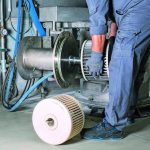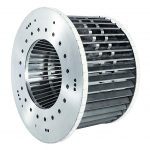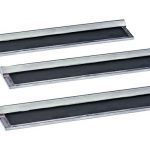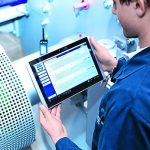The wear-protected ATP-PRO classifying wheel from Hosokawa Alpine combines the advantages of conventional ceramic classifying wheels with those of steel. This unique combination is expressed in the abbreviation “PRO”, which in this instance stands for “protected”. In addition, the uncomplicated exchange of individual vanes reduces the effort for maintenance, transport and storage and makes it possible to employ different vane materials, which in turn extends the range of applications.
The ATP-PRO classifying wheel is not only suitable for use in classifier mills; it can also be employed for classifiers in grinding circuits, e.g. in combination with ball mills, where it serves to boost the performance. In this case, finer products can be achieved and the specific energy consumption of the blowers and classifier drives reduced. The proven operational reliability and easier handling in comparison with ceramic classifying wheels are of great significance, especially with multi-wheel classifiers.
Advantages at a glance
Compared to steel or ceramic wheels of conventional design, the ATP-PRO classifying wheel offers the following advantages:
- Much finer end products
- Improved wear protection due to material diversity
- Speed reduction
- Exchangeable vanes made from different materials
- Less iron contamination
- Low pressure drop
- Reduced maintenance effort
- Lower specific energy consumption
Existing classifiers and classifier heads can be equipped with ATP-PRO classifying wheels with only a minimum of conversion effort, leading to noticeable improvements in terms of fineness, throughput, energy consumption and absence of contamination.
Once the wear protection has reached the end of its service life, the classifier vanes of the most popular machine sizes 200 ATP-PRO and 315 ATP-PRO can be exchanged. Thanks to the new wear-protected classifying wheel, it is now also possible to reap the benefits afforded by the NG geometry when it comes to processing abrasive materials. Different material groups can be combined by means of design measures as well as the use of modern materials and connection techniques. The vanes can be constructed from a combination of metal and non-metal materials for handling particularly abrasive powders, for example. The wear-protection materials can be tailored to individual demands and the classifier vanes replaced as and when necessary.
Tests demonstrate the added value
The potential of the ATP-PRO manifested itself some time ago in the testing centre. Tests with quartz powder not only showed processing performance on the highest level; they also revealed that the selected wear protection promises a long service life. The tests were carried out at up to 150°C to ensure suitability for use in the classifier heads of fluidised-bed opposed-jet mills or mechanical impact classifier mills operated at elevated temperatures. The results achieved in the testing centre during the subsequent validation phase convinced two customers. The ATP-PRO was initially validated for grinding a rare-earth oxide with a Mohs hardness of 5 to 6 using a 400 AFG fluidised-bed opposed-jet mill. The customer concerned had previously relied on a standard steel classifying wheel in the integrated 200 ATP classifier because the traditional ceramic designs were unable to deliver the stipulated fineness values. The downside was the extremely short service life of the classifying wheel. The total contamination with iron compounds in the end product was as much as 100 ppm. During a trial period with the ATP-PRO classifying wheel lasting several months, it was possible to reduce the end particle size by approximately 15 % (d90 = 1.0 μm). Over and above this, the total contamination with iron compounds in the end product was limited to a mere 5 to 6 ppm owing to the new wear protection.
Reduced energy consumption
In a further test, the validation was carried out on a customer’s premises, where a 630 AFG fluidised-bed opposed-jet mill is operated with hot gas in order to process various industrial minerals. A ceramic 315 ATP classifying wheel had been used up to then. As a result of the wear-protected 315 ATP-PRO classifying wheel, the speed was practically halved without compromising the end-product fineness. At the same time, the smaller pressure drop opened the door for a substantial reduction in specific energy consumption. It was possible to manufacture much finer products in this way without any additional measures. The actual status of the machines and necessary maintenance can be identified using the Alpine VIB system. This wireless system measures machine vibration and transfers the results to a tablet computer.
Online search: cpp0317hosokawaalpine
Hall 4A, Booth 233
Vibration measurement : compact and wireless
Whether used to measure random samples taken during regular control processes or to determine specific maintenance requirements, the Alpine VIB system always gives a clear picture of the status of machines and systems. Thanks to this innovative measuring system, vibration measurements can be carried out flexibly and necessary maintenance identified at an early stage. The complete package comprises both software and hardware. Measurements are wireless via a tablet computer. The machine status can thus be individually checked, evaluated and recorded. Damage and system failures are prevented in this way. Installation of the Alpine VIB system is simple and flexible. The battery-operated sensor can be mounted on all machines either magnetically or with a screw connection. A WiFi is used for mobile data transmission between the sensor and tablet. The Alpine VIB software thus visualises and records the measured vibration values. The measurement curves for evaluating vibration levels are calculated from raw data and displayed directly (in accordance with DIN ISO 10816–3). Measurement reports can be generated in a few simple steps. Graphs document the minimum and maximum values as well as variations over time and much more besides.












